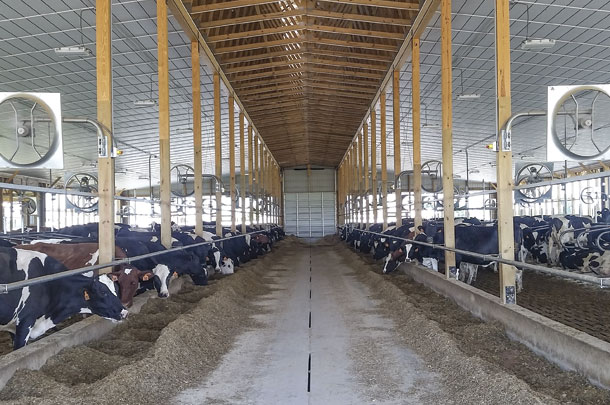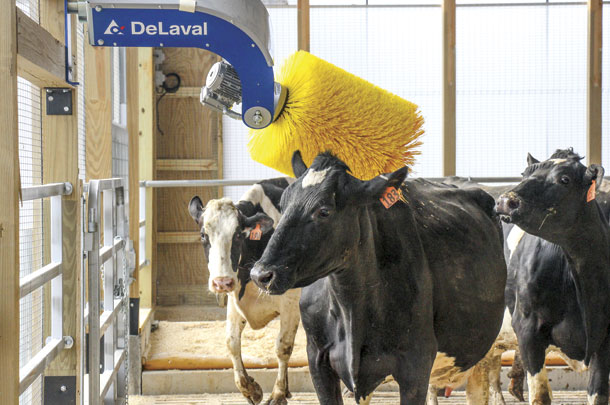While not your traditional path to ownership, Copenhaver – who did not grow up dairying, but began working on a dairy at age 16 – knew that without such an offer, owning a dairy farm might not ever be his reality.
“Without that opportunity, it would have been very tough to get started in the dairy industry,” he says. “I’m very grateful for that opportunity.”
Copenhaver’s journey began with a purchase of one-third of the existing herd and expanded several years later to include a 50-50 partnership with both the herd and the equipment. In 2013, he bought out the dairy farmer, but soon found out that the lease to the rented farmland would not be renewed. Working with rented land had allowed him to build equity with the cows and the equipment, which could readily be moved elsewhere. But if he was going to continue farming, he decided that it only made sense to continue if he could purchase his own land.
Copenhaver’s in-laws, who last operated their farm as a dairy in the 1990s, offered to sell him their Lebanon, Pennsylvania, farm, used for commodity crop production. With outdated facilities, he’d have to build new in order to make the business successful, meet the goals he had in mind and provide the lifestyle his family wanted.
His goal was to dairy “as efficient as possible. No shortcuts on construction,” Copenhaver says.
Providing the highest level of cow comfort that today’s technology and advances in design would allow, which also would increase cow productivity, was a necessity. Eliminating wasted labor hours, to allow free time to spend with his family, was also high on the list of necessities. Not willing to cut corners in the short-term to make the dairy a reality, Copenhaver needed financing.
Resources to build
“When you are going through an expansion project, know your numbers and know how your business is doing,” he recommends. Approach the bank with all of the information already prepared. “If you go in prepared, you are already a step above what the bank was expecting.”
Knowing the cash flow figures, having balance sheets in order and presenting a complete building plan along with estimated costs – plus a dose of confidence – convinced the bank that the dairy would be a profitable operation, and a good risk.
Preparation for the dairy build began well before any construction did. Copenhaver toured numerous dairy facilities, completed a rough design draft and worked with Penn State Extension dairy business educator Timothy Beck to organize the dairy’s finances.
With a team of dairy consultants in place, the facility design was finalized, the permitting process was tackled and the finances kept on track. A cushion of 5% to 10% additional overhead available in the budget throughout the construction process kept unexpected costs from derailing the project.
Another of Copenhaver’s main concerns was whether the milk cooperative would continue to pick up his milk when the cows moved to the new farm. Once that was verified, the final decision to move forward was made. Preparations were completed and construction began in September 2016.
Effective design for labor management
“Dairy can be very time-consuming. One of our goals is to be sure we have family time during the week, and the opportunity to get away with our kids,” Copenhaver says.
In order to do so, he needed to have the right employees. The two full-time and two part-time employees at Talview Dairy transitioned from the old dairy to the new, learning new skills and ways of doing things. The new barn became home to the herd in March 2017.
“I have exceptional employees, and without them, I probably would not be able to go on vacation,” Copenhaver says.
Copenhaver also needed to build the new dairy to take advantage of the available technology to keep things running smoothly, whether he is there or not.
 Ventilation in the newly built freestall barn is automated. Side and front curtains, a humidistat, fans and a sprinkler system were designed with cow comfort in mind. The barn, built for the 240 Holsteins in the milking herd, plus about 40 dry cows, is almost full. In the future, the flexible design plan allows for another barn to be built in conjunction with the first, or for the first barn to be added onto, for a more limited expansion. Calves are housed in individual hutches and fed pasteurized waste milk.
Ventilation in the newly built freestall barn is automated. Side and front curtains, a humidistat, fans and a sprinkler system were designed with cow comfort in mind. The barn, built for the 240 Holsteins in the milking herd, plus about 40 dry cows, is almost full. In the future, the flexible design plan allows for another barn to be built in conjunction with the first, or for the first barn to be added onto, for a more limited expansion. Calves are housed in individual hutches and fed pasteurized waste milk.
The double-12 milking parlor was designed to allow one person to milk efficiently. It can accommodate 500 cows, allowing room for future growth.
Eliminating wasted time and labor meant installing slotted barn floors. Twice per year, he pumps manure out of the barn and into tankers to haul onto the fields. While it requires time to properly agitate the manure storage to reduce the buildup of solids, it only involves two days each spring and fall, while eliminating the daily labor associated with scraping.
Copenhaver does wish he made the feed alley 2 feet wider, along with wider crossovers and gates. Overall, he has found the new barn to be efficient; cow flow works well, and labor is reduced. An Afimilk system monitors activity, milk production, reproduction and herd health.
 Monitoring the daily milk production has been key in operating successfully, as every pound of milk that leaves the farm represents income. Reproduction, and making sure that the cows are bred back, is a part of that equation. Cow longevity has increased, allowing increased flexibility with culling decisions to better meet his goals, he says.
Monitoring the daily milk production has been key in operating successfully, as every pound of milk that leaves the farm represents income. Reproduction, and making sure that the cows are bred back, is a part of that equation. Cow longevity has increased, allowing increased flexibility with culling decisions to better meet his goals, he says.
Copenhaver spends some of the recovered time in the business office. Risk management, financial record keeping and benchmarking of the farm’s performance “are just as important as checking a cow’s health out,” he says.
Future plans
If Copenhaver ever does decide to grow the dairy herd, the planning already done when the new barn and parlor were designed will make additional housing for the herd easy to integrate.
Currently, the farm consists of 270 acres. If the dairy were to expand, Copenhaver would have to find additional land in order to grow additional forage and properly manage manure. His primary forages are triticale, rye and corn silage. He also feeds snaplage, plus a supplemental protein.
Copenhaver strives to be the best at producing milk. Through labor efficiency, forage management and cow productivity, he hopes to gain a competitive advantage. While dairy farmers may need to compete in order to stay in business, they need one another, too.
“I do really feel that the opportunity given me in my startup definitely got me to where I am today,” Copenhaver says. ![]()
PHOTO 1: The double-12 milking parlor sits to the left of the freestall barn. The parlor was built for up to 500 head and designed for one person to milk efficiently. The freestall barn is at capacity at 280, but can easily be expanded, or a second barn can be built, with both options reflected in the original planning.
PHOTO 2: The newly built freestall barn houses the 280-cow herd of Holsteins. Automated curtains and fans keep the cow comfort level high.
PHOTO 3: Cows enjoy the brush – a comfort measure – at the new freestall barn built with slotted floors at Talview Dairy in Lebanon, Pennsylvania. Photos courtesy of Talview Dairy LLC.
Tamara Scully, a freelance writer based in northwestern New Jersey, specializes in agricultural and food systems topics.



